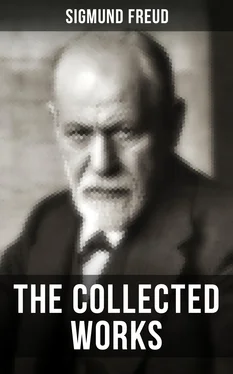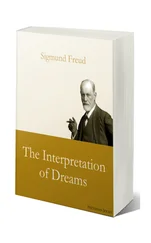I end my exposition with these examples. They are only examples. We know more about these matters, and you may well imagine how much richer and how much more interesting such a collection would appear if made, not by amateurs like ourselves, but by real experts in mythology, anthropology, philology and folk-lore. We are compelled to draw a few conclusions which cannot be exhaustive, but which give us much food for thought.
In the first place, we are faced by the fact that the dreamer has at his disposal a symbolic means of expression of which he is unconscious while awake, and does not recognize when he sees. That is as remarkable as if you should make the discovery that your chambermaid understands Sanskrit, although you know she was born in a Bohemian village and never learned the language. It is not easy to harmonize this fact with our psychological views. We can only say that the dreamer’s knowledge of symbolism is unconscious, that it is a part of his unconscious mental life. We make no progress with this assumption. Until now it was only necessary to admit of unconscious impulses, those about which one knew nothing, either for a period of time or at all times. But now we deal with something more; indeed, with unknown knowledge, with thought relationships, comparisons between unlike objects which lead to this, that one constant may be substituted for another. These comparisons are not made anew each time, but they lie ready, they are complete for all time. That is to be concluded from the fact of their agreement in different persons, agreement despite differences in language.
But whence comes the knowledge of these symbol-relationships? The usages of language cover only a small part of them. The dreamer is for the most part unacquainted with the numerous parallels from other sources; we ourselves must first laboriously gather them together.
Secondly, these symbolic representations are peculiar neither to the dreamer nor to the dream work by means of which they become expressed. We have learned that mythology and fairy-tales make use of the same symbolism, as well as do the people in their sayings and songs, the ordinary language of every day, and poetic phantasy. The field of symbolism is an extraordinarily large one, and dream symbolism is but a small part thereof. It is not even expedient to approach the whole problem from the dream side. Many of the symbols that are used in other places do not occur in the dream at all, or at best only very seldom. Many of the dream symbols are to be found in other fields only very rarely, as you have seen. One gets the impression that he is here confronted with an ancient but no longer existent method of expression, of which various phases, however, continue in different fields, one here, one there, a third, perhaps in a slightly altered form, in several fields. I am reminded of the phantasy of an interesting mental defective, who had imagined a fundamental language, of which all these symbolic representations were the remains.
Thirdly, you must have noticed that symbolism in these other fields is by no means sex symbolism solely, while in the dream the symbols are used almost entirely to express sexual objects and processes. Nor is this easily explained. Is it possible that symbols originally sexual in their meaning later came to have other uses, and that this was the reason perhaps for the weakening of the symbolic representation to one of another nature? These questions are admittedly unanswerable if one has dealt only with dream-symbolism. One can only adhere to the supposition that there is an especially intimate connection between true symbols and things sexual.
An important indication of this has been given us recently. A philologist, H. Sperber (Upsala) who works independently of psychoanalysis, advanced the theory that sexual needs have played the largest part in the origin and development of languages. The first sounds served as means of communication, and called the sexual partner; the further development of the roots of speech accompanied the performance of the primitive man’s work. This work was communal and progressed to the accompaniment of rhythmically repeated word sounds. In that way a sexual interest was transferred to the work. The primitive man made work acceptable at the same time that he used it as an equivalent and substitute for sex-activity. The word thus called forth by the common labor had two meanings, designating the sex-act as well as the equivalent labor-activity. In time the word became disassociated from its sexual significance and became fixed on this work. Generations later the same thing happened to a new word that once had sexual significance and came to be used for a new type of work. In this manner a number of word-roots were formed, all of sexual origin, and all of which had lost their sexual significance. If the description sketched here approximates the truth, it opens up the possibility for an understanding of the dream symbolism. We can understand how it is that in the dream, which preserves something of these most ancient conditions, there are so extraordinarily many symbols for the sexual, and why, in general, weapons and implements always stand for the male, materials and things manufactured, for the female. Symbolic relationships would be the remnants of the old word-identity; things which once were called by the same names as the genitals can now appear in the dream as symbols for them.
From our parallels to dream symbolization you may also learn to appreciate what is the character of psychoanalysis which makes it a subject of general interest, which is true of neither psychology nor psychiatry. Psychoanalytic work connects with so many other scientific subjects, the investigation of which promises the most pertinent discoveries, with mythology, with folk-lore, with racial psychology and with religion. You will understand how a journal can have grown on psychoanalytic soil, the sole purpose of which is the furtherance of these relationships. This is the Imago founded in 1912 and edited by Hanns Sachs and Otto Rank. In all of these relations, psychoanalysis is first and foremost the giving, less often the receiving, part. Indeed it derives benefit from the fact that its unusual teachings are substantiated by their recurrence in other fields, but on the whole it is psychoanalysis that provides the technical procedure and the point of view, the use of which will prove fruitful in those other fields. The psychic life of the human individual provides us, upon psychoanalytic investigation, with explanations with which we are able to solve many riddles in the life of humanity, or at least show these riddles in their proper light.
Furthermore, I have not even told you under what conditions we are able to get the deepest insight into that suppositious “fundamental language,” or from which field we gain the most information. So long as you do not know this you cannot appreciate the entire significance of the subject. This field is the neurotic, its materials, the symptoms and other expressions of the nervous patient, for the explanation and treatment of which psychoanalysis was devised.
My fourth point of view returns to our premise and connects up with our prescribed course. We said, even if there were no such thing as dream censorship, the dream would still be hard to understand, for we would then be confronted with the task of translating the symbol-language of the dream into the thought of our waking hours. Symbolism is a second and independent item of dream distortion, in addition to dream censorship. It is not a far cry to suppose that it is convenient for the dream censorship to make use of symbolism since both lead to the same end, to making the dream strange and incomprehensible.
Whether or not in the further study of the dream we shall hit upon a new item that influences dream distortion, remains to be seen. I should not like to leave the subject of dream symbolism without once more touching upon the curious fact that it arouses such strong opposition in the case of educated persons, in spite of the fact that symbolism in myth, religion, art and speech is undoubtedly so prevalent. Is not this again because of its relationship to sexuality?
Читать дальше












